 Strikes, Wars, and Revolutions in an International Perspective
Strikes, Wars, and Revolutions in an International Perspective Book contents
- Frontmatter
- Contents
- List of contributors
- Preface
- Part I Introductions
- Part II Models and realities
- Part III Workers in metal-processing enterprises in comparative perspective
- Part IV The effects of short-term variation
- 18 Introduction
- 19 Economic cycles and labor conflicts in Germany during the first quarter of the twentieth century
- 20 The crisis of state and society in Britain, 1917–1922
- 21 Strikes and the war
- 22 Labor unrest in Imperial Russia on the eve of the First World War: the roles of conjunctural phenomena, events, and individual and collective actors
- 23 Strikes in Russia, 1917: the impact of revolution
- Part V Conclusion
21 - Strikes and the war
Published online by Cambridge University Press: 25 March 2010
- Frontmatter
- Contents
- List of contributors
- Preface
- Part I Introductions
- Part II Models and realities
- Part III Workers in metal-processing enterprises in comparative perspective
- Part IV The effects of short-term variation
- 18 Introduction
- 19 Economic cycles and labor conflicts in Germany during the first quarter of the twentieth century
- 20 The crisis of state and society in Britain, 1917–1922
- 21 Strikes and the war
- 22 Labor unrest in Imperial Russia on the eve of the First World War: the roles of conjunctural phenomena, events, and individual and collective actors
- 23 Strikes in Russia, 1917: the impact of revolution
- Part V Conclusion
Summary
“In general, one can say that no revolution is possible where the authority of the political body remains intact; that is, in modern circumstances, when one can have utter confidence that the armed forces will obey civil authority.” The First World War brought both coercion, in the form of moral proscription and the threat of sanctions, and the reasons for protest. Exacerbating frustrations even as it reinforced the legitimacy of public authority, the war forged closer and yet more fragile ties between civil and political society. For this reason, the war provides a privileged moment in which to examine the relationship among economic, political, and ideological phenomena. The following pages deal with the study of strike movements not because they played a determinative role in the developments of the war, but because they illustrate the notion that even under extreme conditions, work conflicts are not always purely instrumental actions. What was the meaning of the social consensus of 1914, witnessed by the disappearance of strikes in that year? Why was that consensus no longer so solid in 1917 and 1918 as it had been at the beginning of the war? Did this consensus depend on the absence of political polarization, or did it flow directly from the interplay of moral constraints imposed by the war? At the point when they reappeared, in 1917 and 1918, did the strikes respond to a logic of economic protest, to the appeal of the Russian Revolution, or to marching orders from the defeatists? Did they inscribe themselves within the dominant political configuration?
- Type
- Chapter
- Information
- Strikes, Wars, and Revolutions in an International PerspectiveStrike Waves in the Late Nineteenth and Early Twentieth Centuries, pp. 473 - 499Publisher: Cambridge University PressPrint publication year: 1989


